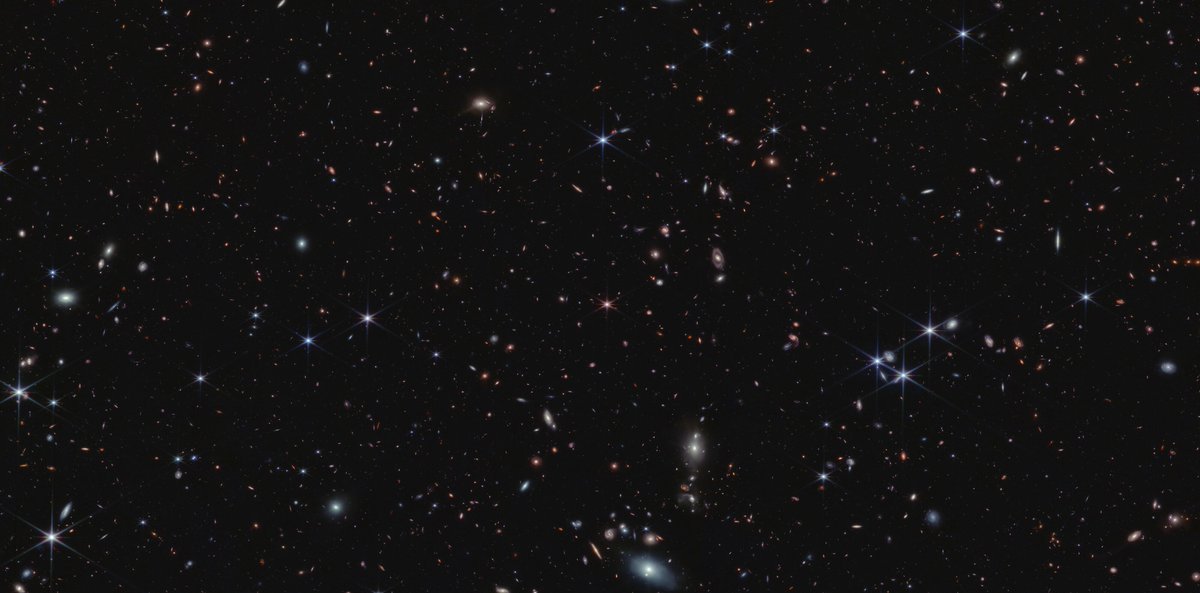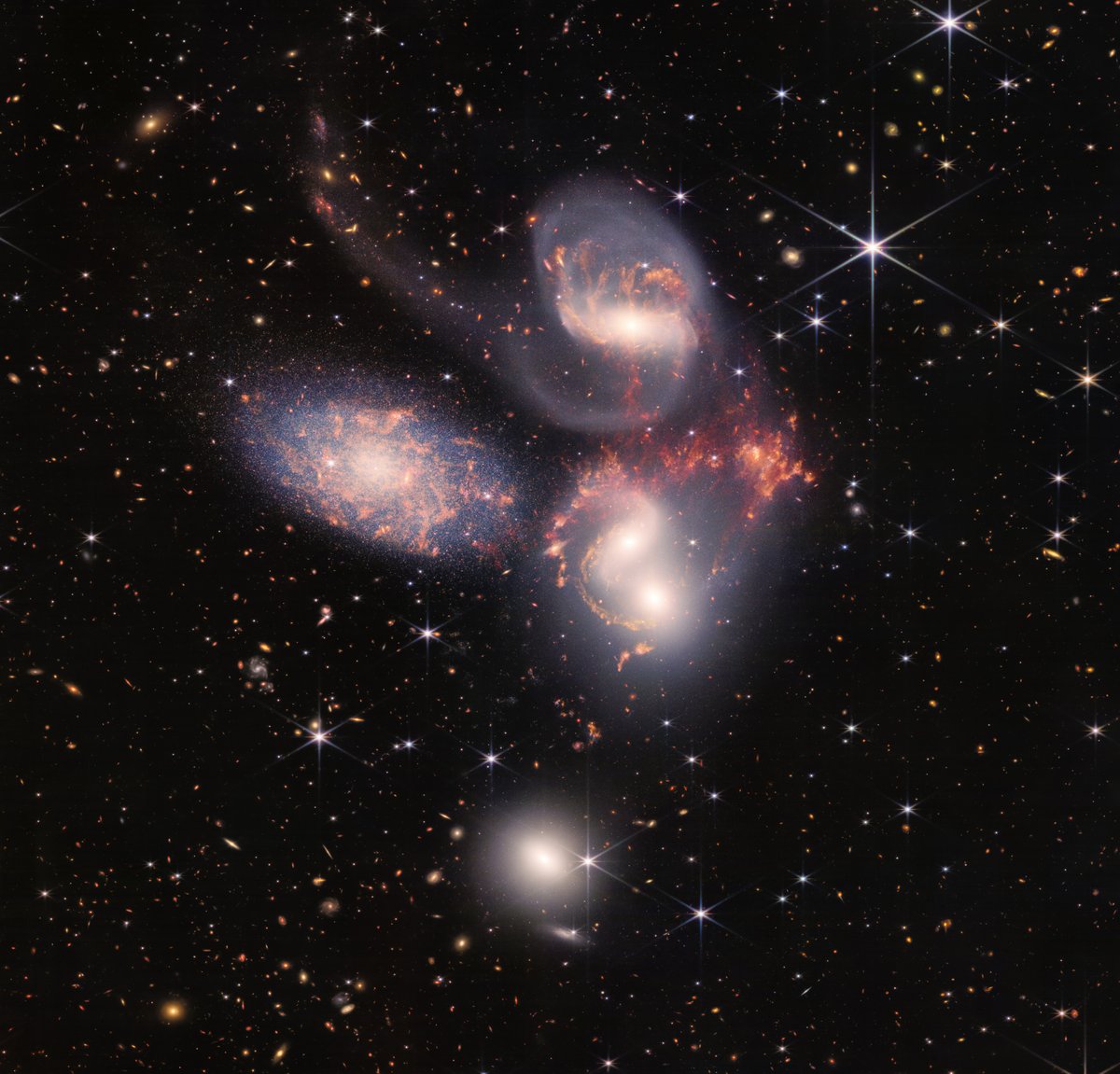
Official @ESA feed for James #Webb Space Telescope – an international partnership between NASA, ESA and CSA #WebbSeesFarther #BFFinSpace with @Hubble_Space
2 subscribers
How to get URL link on X (Twitter) App


 The quasar is at the centre of the image, and appears tiny and pink with six prominent diffraction spikes, acting like a flashlight, illuminating the gas between it and the telescope. 1/6
The quasar is at the centre of the image, and appears tiny and pink with six prominent diffraction spikes, acting like a flashlight, illuminating the gas between it and the telescope. 1/6

 2/ “It was crucial to prove that these galaxies do, indeed, inhabit the early universe. It’s very possible for closer galaxies to masquerade as very distant galaxies,” said astronomer and co-author Emma Curtis-Lake from @UniofHerts UK
2/ “It was crucial to prove that these galaxies do, indeed, inhabit the early universe. It’s very possible for closer galaxies to masquerade as very distant galaxies,” said astronomer and co-author Emma Curtis-Lake from @UniofHerts UK

 2/ In this image, Webb’s image of the Southern Ring Nebula highlights the very hot gas that surrounds the central stars. This hot gas is banded by a sharp ring of cooler gas, which appears in both images.
2/ In this image, Webb’s image of the Southern Ring Nebula highlights the very hot gas that surrounds the central stars. This hot gas is banded by a sharp ring of cooler gas, which appears in both images. 

 2/ The galaxy lies roughly 3 million light-years away and was selected for observations as its gas is similar to that which made up galaxies in the early Universe.
2/ The galaxy lies roughly 3 million light-years away and was selected for observations as its gas is similar to that which made up galaxies in the early Universe.


 2/ Webb is renowned for its mid-infrared capabilities provided by #MIRI. Mid-infrared light, with wavelengths between 3 & 30 micrometres, allows us to see the Universe in a specific way, with objects that appear dark at visible wavelengths shining brightly in the mid-infrared.
2/ Webb is renowned for its mid-infrared capabilities provided by #MIRI. Mid-infrared light, with wavelengths between 3 & 30 micrometres, allows us to see the Universe in a specific way, with objects that appear dark at visible wavelengths shining brightly in the mid-infrared.

 2/ Astronomers used Webb's #MIRI, #NIRSpec, and #NIRCam instruments to investigate IC 1623. This will allow scientists to unravel the interactions in galactic ecosystems. These observations are also accompanied by data from other observatories, like @HUBBLE_space #BFFinSpace
2/ Astronomers used Webb's #MIRI, #NIRSpec, and #NIRCam instruments to investigate IC 1623. This will allow scientists to unravel the interactions in galactic ecosystems. These observations are also accompanied by data from other observatories, like @HUBBLE_space #BFFinSpace 

 2/ The new image, taken by Webb’s Near-Infrared Camera (NIRCam), shows the crisp view of the planet’s dynamic rings. The Webb images also clearly show Neptune’s fainter dust bands.
2/ The new image, taken by Webb’s Near-Infrared Camera (NIRCam), shows the crisp view of the planet’s dynamic rings. The Webb images also clearly show Neptune’s fainter dust bands.

 2/ This near-infrared spectrum of Mars was captured by NIRSpec on 5 September 2022. The spectrum is dominated by reflected sunlight at wavelengths shorter than 3 microns and thermal emission at longer wavelengths.
2/ This near-infrared spectrum of Mars was captured by NIRSpec on 5 September 2022. The spectrum is dominated by reflected sunlight at wavelengths shorter than 3 microns and thermal emission at longer wavelengths.

 The Cartwheel Galaxy, located about 500 million light-years away in the Sculptor constellation, looks much like the wheel of a wagon. Its appearance results from a high-speed collision between a large spiral galaxy and a second smaller galaxy 👇
The Cartwheel Galaxy, located about 500 million light-years away in the Sculptor constellation, looks much like the wheel of a wagon. Its appearance results from a high-speed collision between a large spiral galaxy and a second smaller galaxy 👇

 A transmission spectrum is made by comparing starlight filtered through a planet’s atmosphere as it moves across the star, to the unfiltered starlight detected when the planet is beside the star 👇
A transmission spectrum is made by comparing starlight filtered through a planet’s atmosphere as it moves across the star, to the unfiltered starlight detected when the planet is beside the star 👇

 Called the Cosmic Cliffs, Webb’s seemingly 3D picture looks like craggy mountains on a moonlit evening. In reality, it is the edge of the giant, gaseous cavity within NGC 3324, and the tallest “peaks” in this image are about 58 light-years high 👇
Called the Cosmic Cliffs, Webb’s seemingly 3D picture looks like craggy mountains on a moonlit evening. In reality, it is the edge of the giant, gaseous cavity within NGC 3324, and the tallest “peaks” in this image are about 58 light-years high 👇 

 Stephan’s Quintet is a visual grouping of 5 galaxies with only 4 of the galaxies truly close together & caught up in a cosmic dance — a fantastic “laboratory” for scientists to see in detail how interacting galaxies trigger star formation & how gas is being disturbed 👇
Stephan’s Quintet is a visual grouping of 5 galaxies with only 4 of the galaxies truly close together & caught up in a cosmic dance — a fantastic “laboratory” for scientists to see in detail how interacting galaxies trigger star formation & how gas is being disturbed 👇 

 Some stars save the best for last 💥 Planetary nebulae are the shells of gas and dust ejected from dying stars — making for a spectacular view. Since they exist for tens of thousands of years, observing such a nebula is like watching a movie in exceptionally slow motion 👇
Some stars save the best for last 💥 Planetary nebulae are the shells of gas and dust ejected from dying stars — making for a spectacular view. Since they exist for tens of thousands of years, observing such a nebula is like watching a movie in exceptionally slow motion 👇

 WASP-96 b is a hot, puffy gas giant planet orbiting a distant Sun-like star. On 21 June, Webb’s #NIRISS measured light from the WASP-96 system for 6.4 hours as the planet moved across the star 👇
WASP-96 b is a hot, puffy gas giant planet orbiting a distant Sun-like star. On 21 June, Webb’s #NIRISS measured light from the WASP-96 system for 6.4 hours as the planet moved across the star 👇

 This is Webb’s First Deep Field, the deepest, sharpest infrared image of the distant Universe so far. It shows galaxy cluster SMACS 0723 as it appeared 4.6 billion years ago, with many more galaxies in front of and behind the cluster 👇
This is Webb’s First Deep Field, the deepest, sharpest infrared image of the distant Universe so far. It shows galaxy cluster SMACS 0723 as it appeared 4.6 billion years ago, with many more galaxies in front of and behind the cluster 👇

 @HUBBLE_space @esa 🔴 Launched on 24 April 1990, the NASA/ESA Hubble Space Telescope has made more than 1.5 million observations of about 50 000 celestial objects 👇
@HUBBLE_space @esa 🔴 Launched on 24 April 1990, the NASA/ESA Hubble Space Telescope has made more than 1.5 million observations of about 50 000 celestial objects 👇


 2/ The mosaic was created by pointing the telescope at a bright, isolated star in the constellation Ursa Major known as HD 84406, chosen specifically because it's easily identifiable and not crowded by other stars of similar brightness, which helps to reduce background confusion
2/ The mosaic was created by pointing the telescope at a bright, isolated star in the constellation Ursa Major known as HD 84406, chosen specifically because it's easily identifiable and not crowded by other stars of similar brightness, which helps to reduce background confusion


 1/ The hexagonal shape enables a roughly circular, segmented mirror with "high filling factor and six-fold symmetry." High filling factor just means the segments fit together without gaps, which would not be the case if the segments were circular
1/ The hexagonal shape enables a roughly circular, segmented mirror with "high filling factor and six-fold symmetry." High filling factor just means the segments fit together without gaps, which would not be the case if the segments were circular